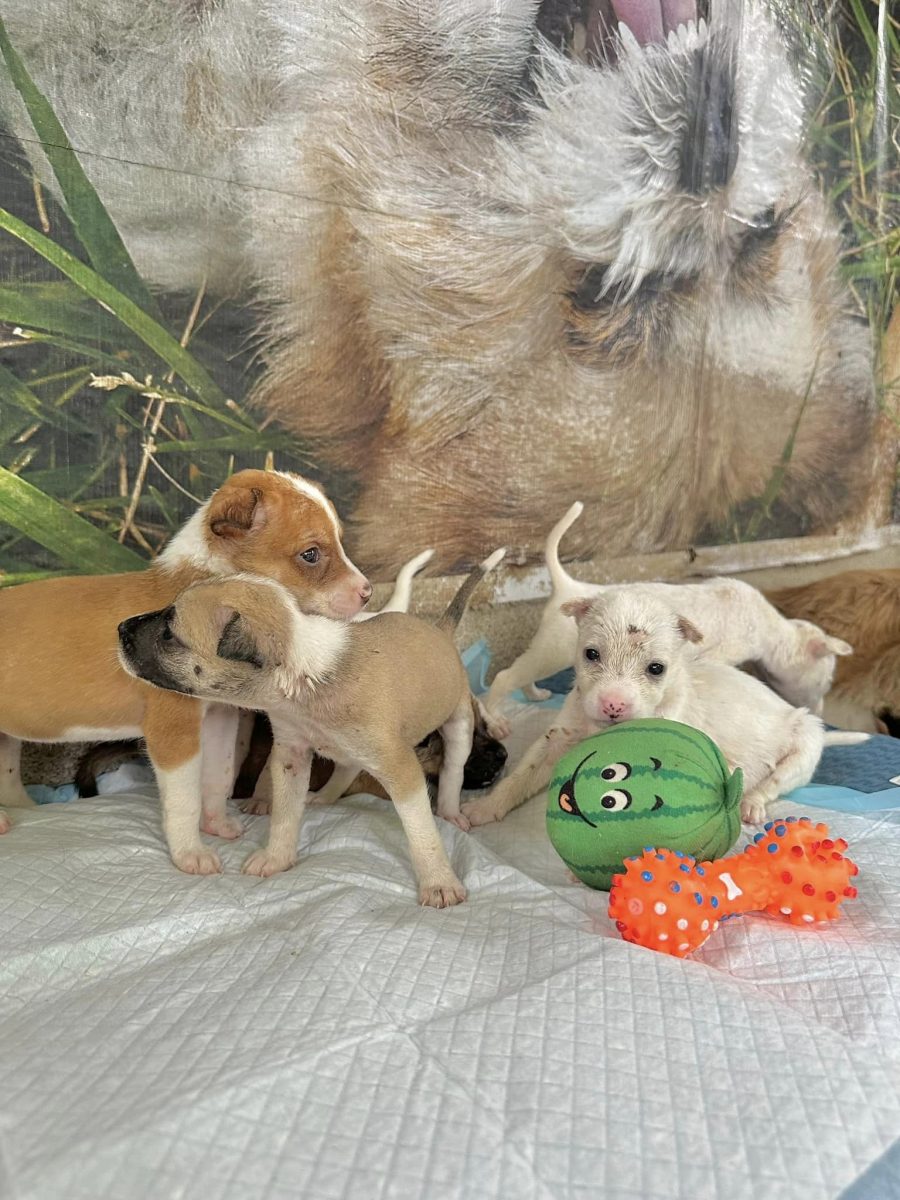A group of recreational cyclists were on their usual trail when a single cardboard box dumped by the bridge made them hit their brakes.
While there is nothing unusual about a cardboard box abandoned by the roadside, it was the strange little noises coming from the inside that attracted their attention.
Not knowing what it could possibly be, the cyclists hopped off their bikes and went to investigate the box.
Once they peeked inside it, they were met with a heartbreaking scene. They simply couldn’t believe how someone could commit such an inhumane act.
Without wasting any time, they quickly reached for their phones and contacted someone for help.
A Heartbreaking Revelation

Inside this cardboard box were nine cruelly abandoned puppies fighting for their life. Six of the puppies were barely two weeks old, with their eyes still closed. All of them were terribly infested with fleas and crying from hunger.
To simply think of these tiny puppies being abandoned, all vulnerable and alone in a world they don’t understand yet, is utterly heart-wrenching.
They were left to suffer, longing for warmth and care they were deprived of from such a young age. Luckily, the cyclists were kind enough to stop and look for help, giving them at least a chance to survive.
On the morning of March 11, the caretakers of PAWSsion Project were alerted by the cyclist who witnessed the horrible scene.

Anguished, the rescuers immediately went to pick up the abandoned puppies.
PAWSsion Project is one of the animal shelters that continues to be the voice for unwanted and voiceless animals in a place where some people still think that animals are something you can just dispose of.
Despite working with many abandoned animals, they still can’t understand how someone can be so cruel as to simply dump tiny little puppies to fend for themselves.
According to Malou Perez, the founder of PAWSsion Project, at the time of the rescue, they were already overcrowded with over 600 animals across their two shelters.
Although they barely had room to house nine more dogs, they simply couldn’t say ‘no’ to these pups.
“We are always just heartbroken. But also, [we felt] gratitude that we were given that chance to save them, especially as they were already within our reach,” Perez told The Dodo.
Better Days Are Ahead

At the rescue, they first had to quarantine the puppies as well as manually remove ticks and fleas.
The caretakers also had to bottle feed the puppies every two hours since they didn’t have their mother dog. It was a lot of work, but it was definitely worth it.
Two weeks after their rescue, the newborn puppies started to open their eyes and eat a lot more. Also their wounds from tick and flea bites were slowly starting to heal.

“It’s always one of the most rewarding feelings,” Perez said.
The rescue hopes to find them all a new home very soon, once they are old enough and ready to go to a foster or forever home.
They are also hoping to rehome some together, but will do everything in their power to find them the best homes possible. It’s the least these poor pups deserve.
In the end, the rescue organization wanted to remind everyone of the importance of spaying and neutering to prevent unwanted litters, as well as the significance of adoption.
It’s the only way to a brighter future, free of innocent little animals abandoned in the middle of nowhere and left to endure unnecessary suffering.
To help these puppies or other animals, please donate to PAWSsion Project.
Ever wondered why your furry companion lets out those soulful howls that seem to echo through the night? It’s a classic canine behavior that often leaves us intrigued. Dogs, our loyal friends, have a unique way of communicating with us through various vocalizations, and howling is just one of their many forms of expression.
When your pup tilts its head back, lets out a haunting howl, and joins the chorus of distant barks, it’s like tapping into their wild ancestry. Understanding the reasons behind this melodious sound can shed light on your dog’s emotions and instincts. So, next time you hear your four-legged friend’s howl, remember, there’s more to it than just a beautiful melody in the air.
Understanding the Behavior of Howling in Dogs
Dogs howl for various reasons, and understanding this behavior can give you insight into what your furry companion might be feeling.
1. Communication
Howling is one way dogs communicate. It can be a means of expressing loneliness, seeking attention, or calling out to other dogs.
2. Instincts
Dogs’ ancestors, like wolves, used howling to communicate with pack members over long distances. Your dog’s howling might be a remnant of this instinct.
3. Emotions
Your dog may howl when they’re anxious, scared, or in pain. It’s their way of vocalizing distress.
4. Environmental Triggers
External factors like sirens, music, or other dogs howling can prompt your dog to join in. They might see it as a response to the noise.
Summary
Understanding why your dog howls is essential for interpreting their feelings and needs accurately. By recognizing the triggers and emotions behind their howling, you can better respond to your furry friend’s communication cues.
Reasons Behind Why Do Dogs Howl
Dogs howl for various reasons, and it’s essential to understand what drives this behavior in our furry companions:
1. Communication:
Dogs howl as a way to communicate with each other or with you. They might be trying to get your attention or alerting other dogs in the area about their presence.
2. Loneliness:
Feeling lonely can trigger a dog to howl, especially when they’re left alone for extended periods. It’s their way of expressing their emotions and seeking companionship.
3. Ancestral Instincts:
Howling is a behavior inherited from dogs’ ancestors, the wolves. It served as a means of communication within the pack over long distances. Your dog might howl as a way to connect with their primal instincts.
4. Emotional Response:
Dogs may howl in response to emotions such as anxiety, fear, or pain. Understanding their howling can provide insights into their emotional state and help you address their needs effectively.
5. External Triggers:
External stimuli like sirens, music, or other howling dogs can also prompt your dog to howl. These triggers can elicit a response in your dog, showcasing their sensitivity to sounds in their environment.
By recognizing the reasons behind your dog’s howling, you can better understand their behavior, emotions, and needs. It’s a form of communication that can convey a lot about how your furry friend is feeling at any given moment.
Howling as an Instinctual Behavior in Dogs
1. Howling to Communicate:
Dogs howl as a way to communicate with other dogs or even with you. It’s their method of sending out signals to connect and convey their emotions, needs, or location. Next time your dog howls, they might be trying to talk to you!
2. Expressing Loneliness:
When a dog feels lonely or separated from their pack (you and your family), they may let out a howl. It’s their way of expressing their emotions and seeking comfort or reassurance from those they care about.
3. Primal Instincts from Wolves:
Dogs are descendants of wolves, and howling is a behavior they inherited from their wild ancestors. This primal instinct serves various purposes, such as coordinating pack movements, claiming territory, or calling out to pack members.
4. Reacting to Emotions:
Similar to humans, dogs experience a range of emotions like anxiety, fear, or even excitement. Howling can be their response to these emotions, signaling their state of mind or trying to cope with what’s happening around them.
5. Response to External Triggers:
External stimuli like sirens, other howling dogs, or even specific sounds in their environment can trigger a dog’s howling. It’s their way of reacting to these stimuli and joining in the “conversation” happening around them.
Understanding why dogs howl helps you decode their messages and respond appropriately. Whether it’s a call for attention, an expression of emotions, or a reaction to external factors, your furry friend’s howling speaks volumes about their needs and feelings.
Training Techniques to Modify Howling Behavior in Dogs
When it comes to addressing howling behavior in dogs, there are effective training techniques you can employ to modify this instinctual response. Here are some strategies to help you manage your dog’s howling:
1. Positive Reinforcement
Encourage quiet behavior by rewarding your dog when they are calm and not howling. Treats, praise, or playtime can reinforce the desired behavior of being quiet.
2. Desensitization
Gradually expose your dog to triggers that cause howling, like sirens or other dogs howling, in a controlled environment. Over time, they may become less reactive to these stimuli.
3. Distraction Techniques
Provide your dog with interactive toys or engage them in activities that keep their mind stimulated, reducing the likelihood of excessive howling due to boredom or loneliness.
4. Consistent Training
Maintain a consistent training routine to establish boundaries and expectations for your dog. Consistency will help reinforce the desired behavior of quietness.
5. Seek Professional Help
If your dog’s howling persists despite your efforts, consider consulting a professional dog trainer or behaviorist. They can provide personalized guidance tailored to your dog’s specific needs.
By implementing these training techniques consistently and patiently, you can effectively modify your dog’s howling behavior and create a harmonious environment for both you and your furry companion.
Conclusion
Understanding why dogs howl is crucial for interpreting their emotions accurately. By recognizing that howling is a natural form of communication for dogs, you can better connect with your furry friend. Implementing effective training techniques, like positive reinforcement and desensitization, can help modify howling behavior. Remember, consistency is key in training your dog. Seek professional help if needed to ensure a harmonious relationship with your pet. By addressing your dog’s howling behavior with patience and understanding, you can create a happy and peaceful environment for both you and your beloved companion.
Frequently Asked Questions
Why do dogs howl?
Dogs howl for various reasons, including expressing loneliness, connecting with their primal instincts, and responding to triggers like sirens or other dogs’ howls. Howling can also be a form of communication to seek attention or express discomfort.
How can I stop my dog from howling excessively?
To reduce excessive howling, consider positive reinforcement training, desensitization to triggers, distraction techniques, consistent training, and seeking professional advice if needed. It’s essential to understand the root cause of your dog’s howling and address it with patience and consistency.
Can professional help be beneficial in addressing my dog’s howling behavior?
Yes, consulting a professional dog trainer or behaviorist can provide tailored strategies to address your dog’s howling behavior effectively. They can analyze the underlying reasons for the howling and create a customized training plan to modify this behavior successfully.
[no_toc]

Hey there, I’m Janet Brooks, a dog-loving student from California. I’m all about helping pups in need, especially those without homes. Me and my awesome friends work together to give shelter and love to stray dogs. Oh, and I also write blogs about dogs to share helpful info.